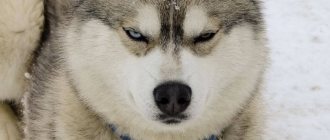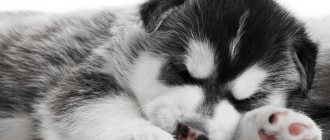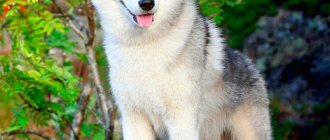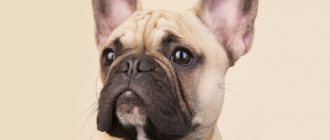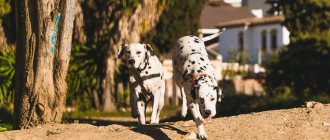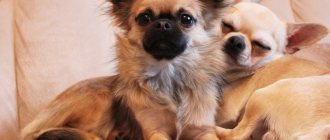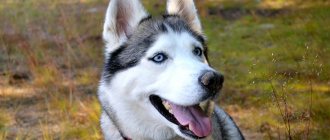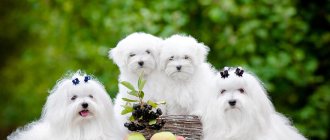Siberian Huskies are a freedom-loving breed of dog, in whose veins flows a mixture of the blood of wolves and northern dogs. The popularity of these blue-eyed dogs is constantly growing, as they are not only a human companion, but also a loyal friend and reliable assistant. In appearance they are similar to a wolf, but their character is friendly and peaceful. This was achieved through long-term selective selection, since the history of the origin of the husky is very mysterious and mysterious. But to understand it, it is worth studying all the stages of formation in order.
The beginning of the history of the origin of the Husky breed
In the area of Lake Baikal, drawings were discovered on the rocks depicting sled dogs. The estimated age of the find is 4 thousand years, but no one can say for sure that these are descendants of huskies. Sled dogs helped nomadic hunters survive in the harsh conditions of Eastern Siberia.
There is an opinion that the breed got its name from the Eskimos, who were called “Eski” for short. Therefore, their dogs began to be called “huskies” on a whim.
In the distant times of the origin of the breed, all sled dogs with a polar color and thick hair were called huskies, without division by species qualities. Subsequently, they began to distinguish a certain category of dogs that had common characteristic features. The energetic dogs were not stronger than the deer, but in terms of endurance they were not inferior to anyone. They could wander for a long time along the snow-covered plains, despite the blizzard and wind, piles of ice and huge drifts. At the same time, their needs for food and rest were minimal.
Cruel selection
Scientists put forward a version that the history of the appearance of the Husky breed is connected with their hereditary relationship with wolves, as indicated by their external similarity. This is based on evidence that northern dogs constantly mated with wild animals. To do this, their owners specially tied the bitch during estrus to places where wolves hunted. As a result, the bred offspring were used for transportation in sleds.
Subsequently, a cruel selection was carried out, as a result of which aggressive and uncontrollable dogs, in whose veins the blood of wolves predominated, were mercilessly eliminated from the rest. This was a necessary measure, since any ignoring of the pet’s commands could cost the hunter’s life. Dogs that could not cope with their duties were castrated. As a result of such selective selection, only elite dogs could reproduce. This ultimately made it possible to obtain the progenitors of the Husky breed.
Transport of gold miners
At the beginning of the twentieth century, the Soviet government recognized the uselessness of this breed of dogs, due to their compact size, which did not allow them to transport heavy loads in sleds. The sharp reduction in the number of dogs was also associated with the established ban on feeding fish to dogs, which was their main food.
It is unknown how it would all have ended if the gold rush had not begun in America. This was the impetus for continuing the story of the origin of the husky dog. Americans were able to appreciate the endurance, energy and ease of care of these northern dogs.
Gold miners massively bought the best huskies from the Chukchi and transported them across the strait to Alaska. Already in America, this breed was given the official name “Siberian Husky”, confirming its true origin.
Origin
It’s not difficult to recognize them - not just dog lovers, but people who are absolutely uninterested in four-legged friends will not be able to ignore these beautiful dogs. Below you can see a photo of a husky.
There are several varieties of these wonderful animals:
- One of the varieties of this beautiful breed is the Alaskan Husky. Already from the name it becomes clear that this is a sled dog, hardy and fast, capable of covering long distances in a harness. This variety is considered one of the most expensive dogs in the world.
- The Sakhalin Husky is considered one of the rarest sled dogs. This is an extremely fast and agile dog, but quite rare, because breeders from distant Japan are struggling to maintain the standard of the species.
- The Siberian Husky is a show-class dog. This is a strong and graceful animal that adapts perfectly to exhibitions and all kinds of shows, as it loves attention to itself. It's sporty and bold, and yet not suited for truly challenging workloads. But he has every chance to win sports competitions. Siberian Husky – photo below.
And yet it should be clarified that the word “husky” that we use in modern times comes from the word “eski”. It's not hard to guess what exactly this word means. In Alaska, these brave dogs were used to search for gold. It was at that time that these mounts showed their best side.
The breed was brought to Alaska as early as 1908 and after that it was regularly imported to participate in racing. The Siberian Husky is one of the oldest breeds that is still popular today. The love for her is supported by the Americans, who especially fell in love with this noble animal.
Continuation of the history of the origin of the Husky breed
Over time, a new sport appeared in America thanks to these unusual dogs - sled dog racing. This not only continued the history of the Siberian Husky breed, but also created an unprecedented excitement around these animals. After all, there was a lot of money at stake, which caused the price of the surviving dogs to rise sharply.
As a result, even small dogs (up to 60 cm), which had previously been rejected, began to be imported to Alaska. The last team from eastern Siberia was exported in 1930. The first official breed standard was recognized in America in 1934.
Early representatives of huskies had more than mediocre appearance, for which they received the nickname “mice.” But their endurance and energy completely compensated for this deficiency. Subsequently, the need for sled dogs grew, so the breed was constantly developing. But it was still used purely for work.
This is how the history of the Husky dog breed continued until the first representatives appeared with an unusual blue eye color and a black “saddle” on the back. This served as the start of selective selection for the beauty of the breed and led to its stratification into three types: working, racing and show dogs.
Origin story
Huskies were bred not only for company while hunting, but mainly as a sled breed . One team needed up to 10 dogs, but since they are unpretentious in food, it was not difficult to keep such a number of animals.
In the 17th and 18th centuries, the Russian Empire began to actively explore the North, which gave a good impetus to the development of sled dog breeding. About 20 animals began to be used for one team, as the sledges increased in size.
The Alaska Gold Rush increased the demand for sled dogs in America. Since the beginning of the 20th century, Americans have imported many Husky dogs from the Far East. Huskies are excellent in rescue operations, and sled dog racing is a fun sport .
Reference . Translated from English, the word husky means “husky.” The dogs were so named for the characteristic sounds they make when growling. Another version says that the name of the breed comes from the word "Eski", a shortened version of the address to the Eskimos.
Homeland of dogs
The origin of the Husky is extremely confusing, but most people believe that the birthplace of the breed is Northeast Asia.
How did you get out?
The friendship between man and husky has lasted for about three thousand years. In fact, this breed was obtained by crossing a northern dog and a wolf . The result was a hardy, loyal and beautiful animal.
In the conditions of the Far North, dogs of this breed turned out to be good helpers for the local population in hunting, protecting houses and reindeer herding.
Northern nomads, in other words, the Chukchi, are the founders of the husky breed.
Where do they live now?
Many sled dogs live in their historical homeland , performing their centuries-old duties - sledding.
But the docile nature, unpretentiousness and beauty of these wonderful animals have long conquered the whole world.
Therefore, Husky dogs can be found in almost any locality.
Heroic feat
The history of the Husky breed is striking in its variety of facts and interesting incidents. One of them should definitely be mentioned below.
Studying the history of huskies, one cannot help but remember how, thanks to these dogs, an entire city was saved from diphtheria. This event occurred in 1925, when an epidemic broke out in the city of Nome, which endangered the lives of many children. Only a special serum that had to be delivered from Anchorage could save them. Bad weather conditions did not allow this to be done by plane. Therefore, it was decided to bring the necessary vaccine by dog sled, despite the distance of 1000 km, snow drifts and severe blizzards. For this purpose, the best representatives of the husky breed were selected.
On the way, something unexpected happened - the person driving the team was paralyzed as a result of severe frostbite. And then the leader of the dog pack, Balto, took control, who realized that the owner was feeling bad and needed to be taken to a populated area. Thanks to the dogs' endurance and energy, the vaccine arrived in Nome on time, which saved the children's lives.
In gratitude for this act of the husky, the image of Balto was immortalized in the form of a monument, which was erected in the Central Park of New York, and became the national treasure of the American people. Until now, the heroic history of the husky is studied in schools and serves as a symbol of endurance, valor, and honor.
Characteristics of the breed
Many livestock breeders are interested in the history of Siberian huskies. The breed was classified in FCI Category 5, which includes primitive, Spitz-type dogs. Their purpose is still unchanged - riding.
According to the generally accepted standard, huskies are characterized by a harmonious physique with developed muscles and strong bones. Males are larger than females. The height of an adult dog at the withers reaches 50-60 cm, and the weight is 23-28 kg. Exceeding these indicators is a disqualifying fault, therefore these dogs are not allowed for further breeding.
The husky's front legs are long, straight and wide-set, and the hind legs are characterized by powerful muscles from the hip. The pads on the limbs are fully adapted to walking on snow, they are tightly compressed, so they do not need to be cleaned after a walk.
The tail is of medium length and strong. The breed standard does not allow the tail to be thrown over the back or curled into a ring. It should be raised with a sickle or lowered low.
The head is of medium size, the features of the muzzle indicate a relationship with wolves. The ears are triangular in shape, medium in size, deep set, and rounded at the tips.
Husky eyes are slanted, their shade can be blue or brown. Heterochromia, when the iris of the eyes has a different color, is not uncommon.
Siberian Husky
The Husky is a medium-sized dog with a beautiful appearance and a strong body. Amazing blue eyes and good-natured character made these dogs very popular. The Siberian Husky, first of all, impresses with its truly stunning appearance. The sharp muzzle makes the dog's head look like the head of a wolf. They are distinguished by very beautiful wool of good density. Huskies have a very lively and active disposition; they easily become attached to their owner. Some are born with eyes of different colors, one brown and the other blue - this feature is not a defect in the breed.
Initially, huskies were bred specifically as sled dogs; they were actively used as part of sleds for transporting goods and moving people. The hunting instinct in dogs is extremely poorly developed. A very friendly breed, both towards its owners and towards other people. The guarding instincts of these dogs are very weakly expressed, almost to zero, and therefore it makes no sense to choose this breed as a guard.
Husky is unpretentious in keeping. Dogs feel great both on the site in a country house and in an apartment. But it should be taken into account that huskies are extremely active, because they were selected for this characteristic for use as sled dogs in the North. Physical endurance has been cultivated by breeders in these dogs for years. Many hours of walks and good exercise are vital for these dogs. If the dog does not find an outlet for its energy, then during your absence it may destroy its place of residence.
Husky dogs have one aesthetic feature that not all owners like. The fact is that as a dog gets older, the color of its eyes may fade. In old age, many representatives of the breed have an almost white iris.
Since huskies are completely non-aggressive, they get along well with all animals. Dogs are friendly towards all family members, love children and play well with them, taking them on sled rides.
Please note that the color of the breed includes various color options. All sorts of shades are allowed, from white-gray, white-black and ending with brown and even white tones.
Many people still confuse huskies with malamutes and huskies. Let's look at their differences below:
Differences between Husky and Laika
Laika is essentially not a separate breed, but a whole group that includes several breeds. Breeds of huskies are different in size, for example, Karelian-Finnish huskies are very small, while Yakut huskies and some others are large), appearance and purpose. Laikas are hunting breeds, and huskies are a specific breed; they do not belong to huskies and are sled dogs . Some huskies can also go in harness, but they cannot withstand long distances and are significantly inferior to huskies in speed and endurance.
The advantage and main difference between Huskies is their unique ability to control their own metabolism. They can speed up or slow down their metabolism, which increases their endurance. A husky can run for 24 hours without stopping, which, unfortunately, a husky cannot do. This breed was bred more for hunting. Moreover, huskies cope equally well with bears, wild boars, game, and fur-bearing animals. Huskies are not your help in this matter. They will not bring any prey, no matter how you teach them. And if, for example, a hare falls into her paws, by the time you get there, there will be nothing left of him. With all this, huskies are, in fact, excellent hunters, but they do it on their own, without an owner. They are especially good at hunting in a pack. This feature makes them very similar to a wolf.
Laikas do not have a bright, but specific smell, something that huskies cannot “boast” of. Huskies have shorter hair, and they do not lay their tail on their back, while huskies have it curled into a ring on their body).
The Yakut Laika is most similar to a husky; they are often confused.
Differences between Malamute and Husky.
The Malamute is larger and more massive than the Husky. The difference in height is 10, even 15 cm. And the difference in weight is from 10 kg.
Malamute eyes are only brown, blue eyes are a defect. The Malamute's ears are rounded , while the Husky's are pointed .
The Malamute's skeleton is more massive, and therefore its paws are more powerful, while the Husky is taller.
The husky's tail is sickle-shaped, low in height, and lowered when at rest. The Malamute's tail is set higher and the dog carries it over its back.
By nature, the Malamute is calm and balanced. Husky is more temperamental. The movements of the Malamute are strong and powerful; the gait of the Husky is lighter, faster and more energetic.
Malamutes and huskies are sled dogs.
Coat type and color
The guard hair of the coat is characterized by medium length and soft structure. It fits tightly to the body, so the lines of the silhouette are clearly visible.
The undercoat is dense, but during the molting period it may be completely absent.
There are about 20 different colors of this breed, and the characteristic “mask” is not a standard sign of purebredness.
The most common Husky color is gray-white or silver-white with a cool undercoat. A rarer pigment is chocolate, brown, red. The most impressive looking are gray huskies, which are most similar to wolves.
The exception is merle, sable, piebald, black, and white wool pigments. Therefore, such huskies are much more expensive.
Appearance
The external characteristics of the breed are quite harmonious. The dogs are short, but they are not shapeless fur barrels. They have a good, proportional figure: the size of the head clearly corresponds to the body. The muzzle is wide at the top, but tapers downwards.
The animal has an upturned tail, muscular, strong paws, as well as pointed triangular ears and the insightful gaze of almond-shaped eyes. They can be brown or blue, and a rare phenomenon occurs when huskies with different eyes appear.
Heterochrony is the answer to the question of why huskies have different eyes. In case of a deficiency or, conversely, an excess of the melanin pigment in the animal’s body, a “multi-colored phenomenon” occurs. It happens that the iris of one eye of an animal can be of different colors.
Standard
According to the standard, the Husky breed must adhere to certain indicators. The weight of the animal varies from 16 to 28 kg. To be more precise, males weigh from 21 to 28 kg, and females from 16 to 23 kg. The height of the dogs reaches 60 cm; these are males; females can grow up to 56 cm.
Coat type and colors
The animal's fur is very thick, but not long.
Husky colors vary, the coat can be:
- black and light gray;
- brown-white;
- brown;
- black;
- white.
Around the eyes the animal may have a mask: white or black, and on the forehead between the eyes there is a funny double stripe.
Character and education
When buying a dog, you need to think not only about its character, but also your own. The owner of this animal must be a leader by nature, persistent and self-confident. At the same time, you cannot overdo it with moralizing and training, otherwise your pet will turn into a circus exhibit. It is much more important to make friends with the animal and develop respect and trust for yourself. The pet must be interested in the company of the owner.
The boundaries in parenting are quite blurred, but they must be adhered to. Huskies are kind dogs, they are friendly and sweet, but they are freedom-loving and rarely give in to direction. A husky puppy should learn this from childhood. This breed, as mentioned above, is very active and strong, so to keep your friend in shape, you will have to carefully consider the training program.
In order to be absolutely sure that the pet will grow into an obedient, but nevertheless self-sufficient dog, you can send it at an early age to specialized courses with a dog handler, who will teach the animal all the necessary commands. At home, Huskies need to be controlled persistently and not unobtrusively. All residents of the house must behave in the same way towards the pet in order for it to develop an association.
If the owner scolds for a certain action, and other family members encourage the animal, the animal may become confused. In addition to this rule, it is also necessary to remember that the pet should not be hit under any circumstances. It is much better if you praise him for good behavior and following commands. Commands can be learned by repetition. If you repeat the command about 20 times a day, forcing you to obey, your efforts will bear fruit and the pet will switch its attention from the object of interest to you.
An extremely interesting fact is that even raising a husky will not force the animal to serve as a guard dog, because they do not bite people and do not behave aggressively towards humans. They can be kind even to a stranger and have little tendency to defend their territory. Representatives of this breed are also very talkative.
Huskies are also not recommended as a hunting dog because the animal tends to eat its prey on the spot. Based on your knowledge of character, you can draw up a suitable behavior pattern on how to care for a husky. Learn more about how to raise a husky in a video from the author of AiFvision.
Character
Dogs have high intelligence and intelligence. But this is often questioned due to the pet’s difficult learning curve. But this is an erroneous opinion, since this breed does not need banal training, but the pet’s interest during the learning process.
Sensing a strong leader in their owner, they quickly master all the necessary skills and develop habits.
Despite their stubbornness and willfulness, huskies are very friendly and friendly. These dogs get along well with all family members, and especially love children. Husky mothers are very caring towards their offspring.
Huskies are not suitable as a guard dog, since they not only do not show aggression towards a stranger, but can also lick him as a greeting.
Varieties: name, description and photo
Thanks to many years of breeding work, there are many varieties of the Husky breed in the world . Each has its own distinctive features. Next, we will describe in detail what types there are, in addition to the well-known Siberian ones, and what are their differences, we will present a description of their character and photos of dogs.
Siberian
Outdoors in winter:
Siberian Huskies on a walk:
Mom and puppy are resting:
The most common breed, popular all over the world.
- Description . Dogs of this breed are short, reaching a height of about 60 cm, and can weigh up to 28 kg. The colors are varied - animals can be white, black, black and white, brown and white, brown and white. Purebred Siberian Huskies are not cheap, up to $1000 for one puppy.
- Character . The dog has a good disposition, intelligence and independence. Can be used for sledding or as a companion. The Siberian Husky is not suitable for the role of a guard dog, as it is too friendly. However, the sledding breed needs a firm hand, otherwise it will become too independent.
- How long do they live ? Life expectancy is 12-15 years.
- Difference from other species . The Siberian variety is distinguished by a variety of colors; these dogs can be of almost any color, unlike other species. They are also very active and agile. This breed requires training, at least at the initial level.
Sakhalin
Sakhalin Husky on a walk:
Male and female for a walk:
Resting after a walk:
A larger breed, up to 65 cm tall, weighing 30-40 kg. Loyal but freedom-loving dogs. Lifespan – 15 years. They perform well both as hunting dogs and as companions . The price of a Sakhalin Husky varies from 200 to 600 dollars.
These dogs are easy to train, but do not tolerate rough handling. When training, you need to be patient and kind.
Since dogs of this breed have a tendency to run away, the owner must be attentive and prudent.
Reference . There have been cases in history when a dog itself opened the door bolt - that’s how freedom-loving these animals are.
Yakut
Yakut Huskies play:
At the exhibition:
Jumping:
This species is medium in size, height no more than 60 cm. A feature that distinguishes the Yakut husky from other varieties is its coat - thick and rough to the touch. Soft fur is considered a fault.
This breed of dog is intended primarily for sledding purposes . Animals have dense muscles and are capable of transporting heavy loads over long distances.
These huskies have a calm character and are very trainable. Among family members they recognize only one owner; they get along well with children.
Japanese
Akita Inu on a walk:
At the exhibition:
Playing with snow:
The Japanese Husky, or otherwise Akita Inu, is a fairly large breed. Males are 67 cm tall, females up to 61 cm. The color can be white or brindle-white, they live 10-14 years.
Akita Inu are very sociable, loyal to their owners, and do not like to be left alone . They were actively used in hunting.
Alaskan
Male and female:
In harness:
In the enclosure:
Alaskan Huskies, as their name suggests, originate from North America. Smart, but willful. Like other representatives of the breed, it requires training.
Dogs of this type of husky reach a height of 66 cm at the withers, weight ranges on average from 17 to 25 kg. The color of the coat can be either monochromatic (brown, red, white) or variegated. The coat is rough and hard to the touch, with a soft undercoat.
Alaskan sled dogs often have brown eyes , which sets them apart from most huskies.
Compared to the Siberian breed, dogs from Alaska are larger in size and have more developed muscles.
Chinese
Chinese Husky asks for a treat:
This is what the puppy looks like:
During sleep:
The Chinese Husky is a rare cross between a Chinese Pug and a Siberian Husky. These mestizos inherited their general appearance from the pug, and their color and good disposition from the husky.
Baikal
In harness:
Before the race:
Male and female in harness:
The Baikal Husky is a cross between the Siberian and Alaskan breeds.
Finnish
On a walk:
At the exhibition:
Gnawing on a bone:
The Finnish Laika, or Finnish Spitz, is a small, beautiful dog, great for hunting . Differs in activity and independence.
The coat color is a beautiful honey shade. Weight does not exceed 15 kg. Eyes can range from hazel to brown. The tail is curled into a ring.
The dog is very emotional, but does not lose its self-esteem.
Training and education
It is necessary to start raising a Husky from the first day this dog appears in the house. This will allow you to accustom your wayward dog to basic commands. At the age of six months, it is recommended to entrust the pet to a professional dog handler who can direct the dog’s stupid energy in the right direction.
If this is not possible, training should be carried out independently. In this case, you should adhere to the following recommendations:
- One line of education. All family members must adhere to the same line of behavior, otherwise the dog will not be able to understand why he is either praised or scolded for the same thing.
- The use of physical punishment is unacceptable. Carrot and stick behavior is not acceptable with Huskies. When completing tasks, the dog should be rewarded with a treat, and if it is not completed, its attention should be switched.
- Multiple repetition of commands. You can achieve precise completion of a task only by repeating it several times a day. At the same time, the owner’s task is to interest the pet in performing them.
- Increased physical activity. Judging by history, Siberian Huskies have high endurance. And in the absence of great physical activity, their energy is destructive. Therefore, the more the dog exercises, the healthier and more active he will be.
About habits as key aspects of character
Of course, it is difficult to disagree with the fact that there are a lot of individual character habits, some of which are features of raising a husky.
However, there are a number of habits that a dog of this breed is subject to from birth:
- Stubbornness is something that can be found quite often in reviews about a puppy and an adult dog. However, I noticed that owners interpret this character trait differently. Some call it self-sufficiency, independence. In any case, I would not recommend the breed for beginners. Following on the heels of the owner, unconditional devotion - for these purposes, in my opinion, dogs such as a retriever and a German shepherd are better suited. The Husky has historically proven itself to be a loyal dog, and this is true. However, she also has such a virtue as intelligence. Cunning comes from the mind - if the dog does not want to carry out any order, it will not be difficult for the dog to find a way around it. Both a puppy and an adult Siberian dog equally have the peculiarity of periodically testing their owner’s strength.
- Vagrancy - not only the small, but also the adult representative of this breed is distinguished by an increased interest in the world around him. I must say that all huskies suffer from a similar tendency. However, the Siberian Husky has such characteristics as curiosity and gullibility. In connection with the above, I strongly advise against letting your husky go for a walk alone. Judging by the reviews, it will take a long time to find the animal. Especially in urban environments.
- Digging is a characteristic of many huskies. Moreover, it often doesn’t matter to them what exactly to dig - a small hole that turns up or a large hole, the owner’s carefully formed beds, a hole under the fence. The owner often has the opportunity to observe such archaeological endeavors. Especially if several huskies are walking in one place - in this case, all the natural dignity of the dogs instantly disappears, and the ground begins to look like it did after the bombing. But even in apartments, digging often continues, which is why the owner has every chance of losing tiles, linoleum, and carpet. How to deal with this? I would advise you to influence such a feature of the husky’s character as hard work - you need to give them more loads.
Health
Huskies are distinguished by good health. But there are diseases to which they are most susceptible.
Types of pathologies:
- Hip dysplasia. The disease negatively affects the dog’s entire musculoskeletal system, which prevents him from moving normally. To eliminate the pathology, medication and physical therapy are prescribed.
- Juvenile cataract. Consolidation of the pupil, which reduces visual acuity. Develops before the age of two years. It can only be eliminated surgically.
- Retinal atrophy. Dystrophic changes in the retina, which lead to complete blindness. It often affects both eyes at the same time.
Rules of care
According to the history of the breed, huskies are not demanding in terms of living conditions. Caring for them comes down to following standard rules:
- Feeding. Despite their natural endurance, huskies suffer from a weak stomach, so their diet should be enriched with protein and fatty foods. When choosing dry food, you should pay attention to premium products, since cheap food does not contain the necessary amount of vitamins and minerals for a dog’s health. When feeding natural products, the husky's diet should include beef, veal, poultry, sea fish, offal, vegetables, and fruits. You also need porridges that can be steeped in boiling water without further preparation.
- Grooming. The coat should be brushed once a week. But during the molting period, which occurs twice a year, this procedure should be carried out regularly once a day. You should wash your pet no more than once a month.
- Eye cleaning. This procedure is carried out as needed when dust, debris, or discharge collects in the dog’s eye. You should rinse your eyes from the outer corner to the bridge of your nose with boiled water.
- Teeth cleaning. The procedure should be done when plaque or tartar appears. In the first case, you can use a special brush and paste, which are sold in a pet store. In the second case, the cleaning is carried out by a veterinarian.
- Ear care. You should wash your ears as they become dirty no more than once every 2 weeks. To do this, it is recommended to soak a cotton pad in boiled water, squeeze out excess liquid and gently wipe the ears.
- Walks. Huskies are not meant to live in an apartment; they need a house with a yard where they can feel at ease. In addition, the dog needs to be walked twice a day, for at least 20-30 minutes. In this case, the walk should be active with increased physical activity.
Maintenance and care
The Siberian Husky is an unpretentious breed of dog. It is better to keep such a dog in a private home, but it should not be deprived of communication with the owner and household members. A husky at home requires care, but not as intrusive as with other dogs.
Here are some rules:
- Huskies can be bathed twice a year, because the pet itself monitors the cleanliness of its coat. But you need to be prepared for the fact that the dog sheds twice a year, and the pet’s coat is renewed within 3 weeks.
- You can periodically check the animal's claws and trim them if necessary.
What to feed your husky needs to be decided in advance. When it comes to feeding, a dog is not much different from others. When the husky is still a puppy, you need to decide which food you think will be more suitable: natural or dry.
It is important to take into account the quality of the components in the animal’s diet, because otherwise it will gain excess weight, lose agility and lose muscle tone.
You may need to consult a veterinarian before feeding your husky puppy, but basically the diet follows the standard rules:
- Do not feed food from the master's table, because it contains a lot of carbohydrates.
- The diet should contain vegetables, fruits and herbs to keep the body's microflora in good condition.
- Husky food must contain vitamins and microelements.
With a husky you need to keep your eyes open. Like other breeds, these dogs have their pros and cons.
The undoubted advantages include:
- kindness and friendliness;
- excellent health, especially with proper nutrition and good ears;
- amazing endurance;
- non-conflict towards other people and animals;
- wool does not have an unpleasant odor.
The disadvantages include:
- stubbornness;
- reluctance to obey commands;
- desire to take leadership positions;
- heavy shedding;
- Some owners may also consider the need for the pet to get enough physical exercise every day to be a disadvantage.
Advantages of the breed
Before making your final choice, it is worth considering the main advantages of a husky:
- High level of intelligence and intelligence.
- Friendly towards all family members and other pets.
- Increased care for your offspring.
- The wool does not have the characteristic dog smell.
- Endurance and high level of immunity to common diseases.
- Unpretentious in care.
- He eats little.
- They are not dominant, so they rarely come into conflict with other dogs.
Photo gallery
Photo 1. Husky with blue eyes
Photo 2. Siberian Husky
Photo 3. Husky puppies
Photo 4. White husky
Photo 5. Dog in the snow
Photo 6. Husky puppies
Flaws
In addition to the advantages, there are also certain disadvantages, which is due to the history of the Husky breed:
- They prefer to pull on a leash when walking, as they are sled dogs.
- Instead of loud barking, huskies prefer to howl, which indicates their origin.
- They are stubborn and willful, which makes parenting difficult.
- Not suitable as guards.
- Need increased physical activity.
- Not suitable for keeping in a booth or small apartment.
- They need special training.
Having studied the history of the Husky breed, you can understand that this type of dog has irrepressible energy, the ability to survive in harsh conditions and perseverance in achieving goals. Therefore, in order to curb such a pet, you need to have enough strength and perseverance, otherwise this northern pet will establish its own rules in the house.
